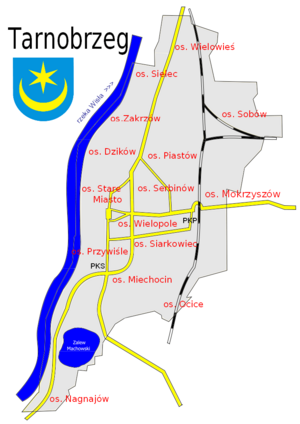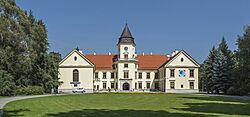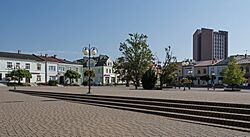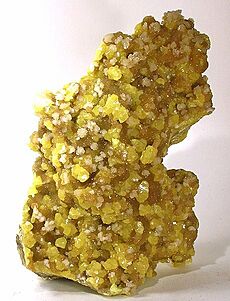Tarnobrzeg facts for kids
Quick facts for kids
Tarnobrzeg
|
|||
|---|---|---|---|

Skyline with Dzików Castle, city center, river Vistula and Reservoir Machów created in a former sulfur mine
|
|||
|
|||
| Country | |||
| Voivodeship | |||
| County | city county | ||
| City rights | 1593 | ||
| Area | |||
| • Total | 85.6 km2 (33.1 sq mi) | ||
| Elevation | 160 m (520 ft) | ||
| Population
(2017)
|
|||
| • Total | 47,387 | ||
| • Density | 553.6/km2 (1,433.8/sq mi) | ||
| Time zone | UTC+1 (CET) | ||
| • Summer (DST) | UTC+2 (CEST) | ||
| Postal code |
39-400
|
||
| Area code(s) | +48 015 | ||
| Car plates | RT | ||
| Website | http://www.tarnobrzeg.pl/ | ||
Tarnobrzeg is a city in south-eastern Poland. It sits on the east bank of the Vistula river. As of 2009, about 49,419 people lived there. Since 1999, Tarnobrzeg has been part of the Subcarpathian Voivodeship. Before that, it was the capital of its own province from 1975 to 1998.
The city's history began in 1593. That's when it received "Magdeburg rights," which allowed it to become a self-governing town. For many years, Tarnobrzeg stayed small. It only grew a lot after World War II. This growth happened because large amounts of sulfur were found nearby. The city then became an important industrial center for sulfur mining.
Contents
What's in a Name?
The name Tarnobrzeg comes from the Tarnowski family. They were the ones who founded the city. Other names were thought of, like "Nowy Tarnów," but Tarnobrzeg was chosen. Other towns founded by the Tarnowski family also have similar names, like Tarnogród.
For a long time, people didn't often use the name Tarnobrzeg. They usually called the area Dzików or Miechocin. These places were older and more important back then. But after a train station called Tarnobrzeg opened in 1887, the name became popular. The region's special saint is still called Our Lady of Dzików.
Where is Tarnobrzeg Located?
Tarnobrzeg is on National Road 9, which is part of a bigger European route. It's also a place where many train lines meet. There are five train stations within the city limits. Trains go from Tarnobrzeg in four directions: south, southeast, east, and north.
Today, Tarnobrzeg is one of Poland's largest cities by land area. It covers about 85 square kilometers (33 square miles). The distance from its northern to southern parts is about 20 kilometers (12 miles). This happened because Tarnobrzeg became a provincial capital in 1975. To make the city bigger, local leaders added many nearby villages. These villages, like Machow and Dzików, became new districts of Tarnobrzeg. Because of this, most of Tarnobrzeg was built after World War II. The old town center is actually quite small.
City Districts
Tarnobrzeg has many different areas. These include Wielowieś, Sielec, Chwałki, Borów, Wymysłów, Zakrzów, Zwierzyniec, Dzików, Podłęże, Serbinów, Nadole, Old Town, Wielopole, Biała Góra, Podchoiny, Chomki, Siarkowiec, Skalna Góra, Przywiśle, Mokrzyszów, Piastów, Sobów, Chałupki, Miechocin, Ocice, Kozielec, Kajmów, Machów, and Nagnajów.
Tarnobrzeg's Past
Tarnobrzeg was founded in 1593. This was during a time known as the "golden age of Poland." The city was meant to be the home of the important Tarnowski family. King Sigismund III Vasa gave the village its city rights on May 28, 1593. Stanislaw Tarnowski was the person who founded the town.
In 1772, Tarnobrzeg became part of the Austrian Empire. It stayed in a province called Galicia until November 1918. Tarnobrzeg was very close to the border with Russia. Because of this, it was badly damaged during World War I.
After World War I, a short-lived state called the Republic of Tarnobrzeg was declared here. In 1919, the town became part of the new independent country of Poland. Many people moved away from the city during the years between the two World Wars (1919–1939). A public school system was started during this time.
In the 1950s, scientists found a lot of sulfur nearby. The city then grew very quickly from the early 1960s. Its population went from 5,000 to 50,000 by the 1990s. But after the sulfur mines closed, Tarnobrzeg's growth slowed down. In 1999, it stopped being a provincial capital.
The Tarnowski Family's Influence
The history of Tarnobrzeg is closely connected to the noble Tarnowski family. In 1349, Rafal of Tarnów married Dzierzka, who owned Wielowieś. They moved there and slowly bought more land. By the late 1400s, Jan Spytek Tarnowski bought Dzików and its strong castle.
Stanislaw Tarnowski (1541–1609) convinced King Sigismund III to grant city rights to "Nowy Tarnów," which later became Tarnobrzeg. His son, Michal Stanislaw, started to expand and modernize the town in the 1620s. He planned the streets and a market square. He also made the Dzików castle and the church at Miechocin bigger.
The city's growth stopped when the Swedish army invaded Poland from 1655 to 1660. The Swedes destroyed the town. After the invasion, Jan Stanislaw Tarnowski built a Dominican Monastery. He moved a special painting of Our Lady of Dzików there from the Dzików Castle. In 1734, an important group called the Dzików Confederation was formed at Dzików Castle. The last owners of Dzików Castle were Jan Zdzislaw Tarnowski and Artur Tarnowski.
The Jewish Community
Before the Holocaust, Tarnobrzeg had a lively Jewish community. Many Jewish people from Tarnobrzeg and their families are known as "Galician Jews."
From 1772 to 1918, Tarnobrzeg was part of the Austro-Hungarian Empire. During the 1800s, after the Napoleonic Wars, there was a time of peace. Jewish people in Tarnobrzeg, like other citizens, benefited from free public education. This was ordered by the Austrian Emperor. This was different from other Jewish communities in Poland at the time.
The peace in Tarnobrzeg ended with World War I. This made the future difficult for the city's Jewish people. Many were forced to move to Russia during the war. This broke up their community. Many also moved to the United States or Palestine.
There were different groups within the Jewish community before World War II. These included Hasidic Jews and groups who supported Zionism. Many Jewish citizens moved to Palestine (which later became Israel) before World War II.
A well-known Jewish citizen of Tarnobrzeg was Moses Hauser. He was a rich businessman and landowner. His life is written about in a special book published after the Holocaust.
World War II and Tarnobrzeg
Before the German and Soviet armies invaded Poland in September 1939, about 3,800 Jewish people lived in Tarnobrzeg. The Germans took over the city on September 17, 1939. To scare people, five important Jewish men were shot in the town square.
Starting in October 1939, many Jewish people were forced to leave Tarnobrzeg. They were sent to the Soviet-controlled area or to other Polish towns. The terrible actions of the German occupiers during the Holocaust forced Jewish people to either try to escape or face death. Very few Jewish people survived in the city. Those who went to Russia had to choose between becoming Soviet citizens or being sent to work camps in Siberia. Many died in these camps because of the harsh conditions. Those who survived were allowed to leave Russia after World War II.
Tarnobrzeg's Economy
Tarnobrzeg used to be a major center for mining and processing sulfur. But because it became less profitable, the mines closed. The Piaseczno mine closed first. Then the Machów mine closed after 40 years. It was the biggest open-pit sulfur mine in Europe. Finally, the Jeziórko mine closed in the 1990s. This mine stayed open longer because it used a modern way to get sulfur called the Frasch process.
Since the 1980s, the land where the mines were has been cleaned up and made useful again. The Machów mine has been filled with water. It is now a lake used for fun activities. The Jeziórko mine is also being filled with water from the nearby Vistula river.
Places to Visit
| Place: | Photo: | Information: | Notes: |
|---|---|---|---|
| Dominican Church and Convent |  |
This is a beautiful Baroque monastery from the late 1600s. It's a special place for Our Lady of Dzików. It's also part of the St. James Lesser Polish Way walking route. You can find it near Głowacki Square in the Old Town. | Open 6am – 7pm. Please don't visit during church services. |
| Chapel and Monastery of Dominicans Sisters and church of St. Michael and St Gertrude in Wielowieś |  |
This group of buildings is from the mid-1800s. The tomb of Róża Kolumba Białecka, who founded the community, is here. The church's history goes back to the 1200s. People believe the first wooden church was linked to St. Hyacinth. | Conservation work is happening inside the church. |
| Dzików Castle with park and garden complex |  |
Work is being done to move the Historical Museum of the City here. | The castle is being restored. You can visit the cellars. It's open Tuesday to Friday from 10am to 4pm, and Sunday from 12pm to 4pm. It was expected to fully reopen in 2011 or 2012. |
| Jewish Graveyard |  |
This graveyard was started in 1930. | It is currently closed to visitors. |
| Tarnobrzeg synagogue |  |
This building was built in the late 1800s. Now, it's used as the Municipal Public Library. | Open Monday to Friday from 10am to 6pm, and Saturday from 8am to 3pm. |
| Church of Mary Magdalene in Miechocin | 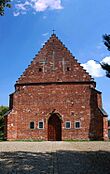 |
This is a Gothic church from the 1300s. Its history goes back to the very early days of Christianity in Poland. | Closed except during worship services. Weekdays at 6pm, Sunday and holidays at 7:30am, 10:35am, 5pm. |
| Shindler's Hunting Palace in Tarnobrzeg Mokrzyszów |  |
This is a Neo-Gothic building from the 1800s. Today, it's used as a Centre for Teacher Education. | |
| Church of Our Lady of Perpetual Help in Serbinów |  |
This church has a very large mosaic in its main area. It also holds relics (special items) of many saints. | The Perpetual Adoration Chapel is open all day and night. The main church is open during worship services. Weekdays at 6am, 8am, 3pm, 6pm. Sunday and holidays at 7am, 8:30 am, 10am, 11:30am, 1pm, 4pm, 5pm, 7:30pm. |
| Padewicz Manor House in Tarnobrzeg-Nagnajów | This is a classical style building. It's located near Wisłostrada Street. | It is closed. | |
| Zwierzyniecki Wood | 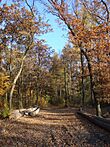 |
This is a remaining part of the Sandomierska Wilderness. | Zwierzyniecka Street leads from the Dzików Castle through Serbinów to this wood. |
| Machowski Reservoir | This is a man-made lake. It was created where a sulfur mine used to be. It's near Wisłostrada Street. | It opened in 2010. | |
| Former Tarnobrzeg Granary in Wymysłów |  |
This building was built in 1843. Now, it's used as the Historical Museum of the City. | Open Tuesday to Friday from 8am to 3pm, and Saturday from 12pm to 4pm. |
| Monument of Bartosz Głowacki | 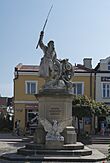 |
This monument was built in 1904. It stands in the main Town Square, across from the Dominican Monastery. | |
| Tarnobrzeg City Hall |  |
This building has an eclectic style and was built in 1910. It used to be the County Hall. Now, it's the office of the Mayor of Tarnobrzeg. It's near Surowieckiego Square. | Open 7:30am – 3:30pm. |
| Former Burgher Casino | This building was built in the early 1900s. Now, it's the Community Centre of Culture. It's located near Sokola Street. |
Churches and Parishes
Tarnobrzeg has many Roman Catholic churches and parishes:
- Church of Mary Magdalene – dating back to around 1160.
- Church of Saint Gertrude and Saint Michael – the first church was built in the 12th century.
- Monastery of Dominicans – built in 1667 (wooden) and 1706.
- Church of Our Lady of Perpetual Help – the current church was built in 1984.
- Church of Good Shepherd – built in 1990.
- Church of Our Lady of Częstochowa in Tarnobrzeg – built in 1991.
- Church of Saint Barbara – the current church was built in 1996.
- Church of Divine Mercy – built in 1996.
- Church of Visitation – built in 1997.
- Church of Christ the King – built in 2003.
- Chapel of All Saints – built in 2009.
- Monastery of Dominicans Sisters in Tarnobrzeg
Sports in Tarnobrzeg
- Siarka Tarnobrzeg – a local football (soccer) club.
- Tarnobrzeg Municipal Stadium – the city's main sports stadium.
Yearly Events
Tarnobrzeg hosts several fun events throughout the year:
- New Year's Run – in January.
- Tarnobrzeg Days – in May or June.
- International Organ Virtuoso Performances – in July and August.
- Saint Dominic's Fair – in August.
- Bartoszki Film Festival – in August.
- Satyrblues – in September.
- International Alfred Freyer Vistula River Run – in October.
- Tarnobrzeg Social Days and Tarnobrzeg Days of The Christian Culture – in October.
- Barbórkowa Drama Teatralna – in December.
Sister Cities
Tarnobrzeg has special connections with other cities around the world. These are called "twin towns" or "sister cities":
 Banská Bystrica in Slovakia (since 1995)
Banská Bystrica in Slovakia (since 1995) Chernihiv in Ukraine (since 2008)
Chernihiv in Ukraine (since 2008)
See also
 In Spanish: Tarnobrzeg para niños
In Spanish: Tarnobrzeg para niños





